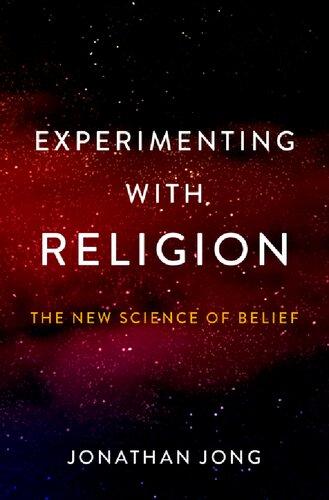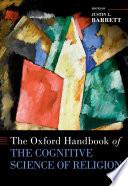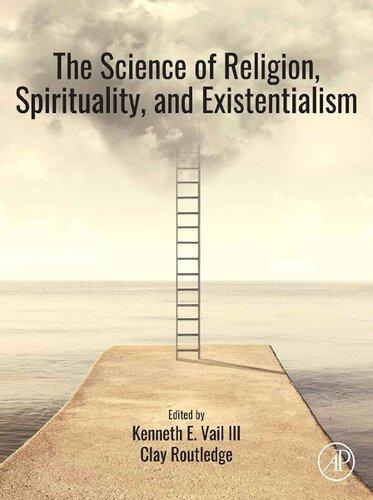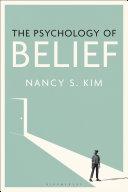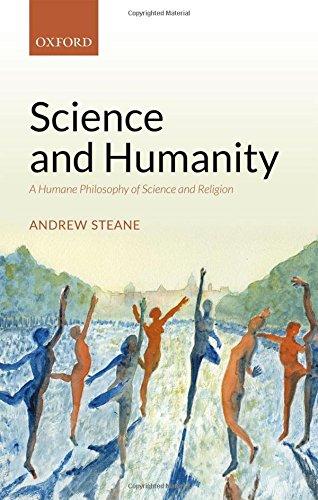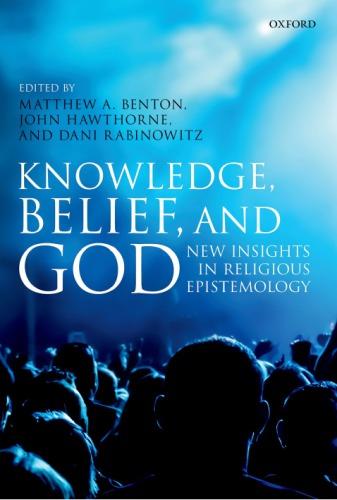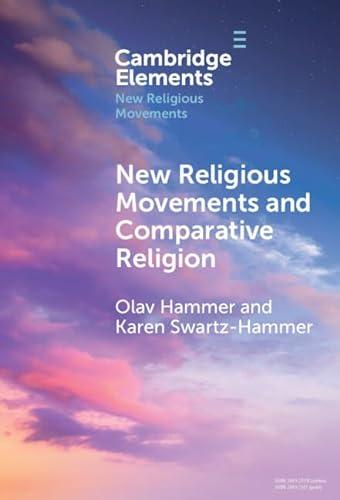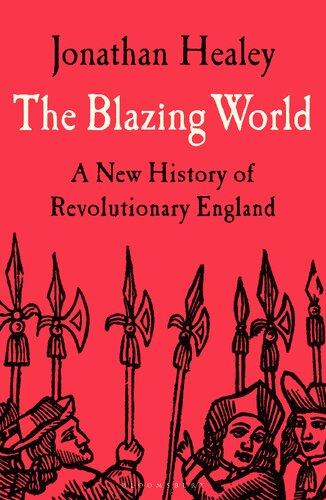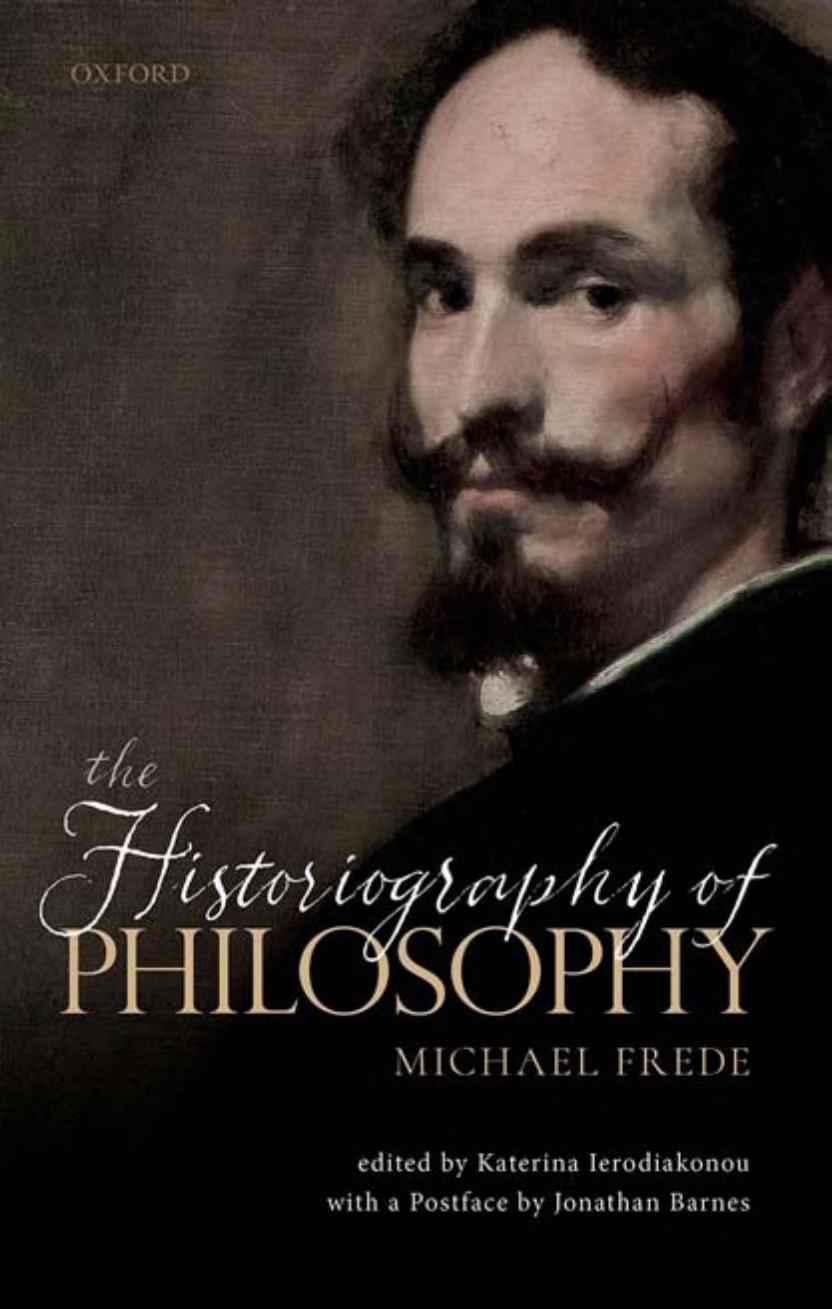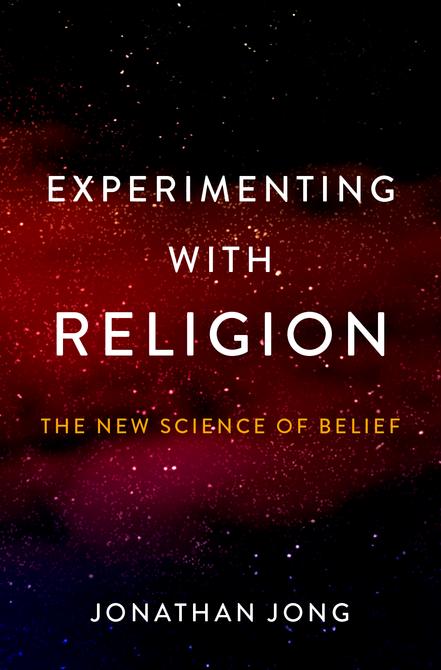Experimenting with Religion
The New Science of Belief
JONATHAN JONG
Oxford University Press is a department of the University of Oxford. It furthers the University’s objective of excellence in research, scholarship, and education by publishing worldwide. Oxford is a registered trade mark of Oxford University Press in the UK and certain other countries.
Published in the United States of America by Oxford University Press 198 Madison Avenue, New York, NY 10016, United States of America.
© Oxford University Press 2023
All rights reserved. No part of this publication may be reproduced, stored in a retrieval system, or transmitted, in any form or by any means, without the prior permission in writing of Oxford University Press, or as expressly permitted by law, by license, or under terms agreed with the appropriate reproduction rights organization. Inquiries concerning reproduction outside the scope of the above should be sent to the Rights Department, Oxford University Press, at the address above.
You must not circulate this work in any other form and you must impose this same condition on any acquirer.
Library of Congress Cataloging-in-Publication Data
Names: Jong, Jonathan, author.
Title: Experimenting with religion : the new science of belief / Jonathan Jong.
Description: New York, NY : Oxford University Press, [2023] | Includes bibliographical references and index.
Identifiers: LCCN 2022054439 (print) | LCCN 2022054440 (ebook) | ISBN 9780190875541 (hb) | ISBN 9780190875565 (epub) | ISBN 9780197677568
Subjects: LCSH: Religiousness. | Psychometrics.
Classification: LCC BV4509.5 .J665 2023 (print) | LCC BV4509.5 (ebook) | DDC 200.1/9—dc23/eng/20230110
LC record available at https://lccn.loc.gov/2022054439
LC ebook record available at https://lccn.loc.gov/2022054440
DOI: 10.1093/oso/9780190875541.001.0001
Printed by Sheridan Books, Inc., United States of America
For Ella Mae, my one; and Edith, ours
Preface and acknowledgments
This is not a book about religion. There is a lot about religion in it, but it is really a book about science. More specifically, it is a book about experimental psychology, and how a group of experimental psychologists have used the tools of this trade to study religion as a human phenomenon. For the past decade, I have counted myself lucky to join these scientists in the pursuit of understanding how and why people believe in things like gods, souls, and rituals. I am additionally grateful for their time and cooperation as I was writing this book, without which it would not have been possible. In an important way, this book is as much about them as about their research. Special thanks, then, to Will Gervais, Bob Calin-Jageman, Deborah Kelemen, Justin Barrett, Bruce Hood, Nathalia Gjersoe, Ben Purzycki, Cristine Legare, Ken Vail III, and Brittany Cardwell for speaking with me at length. I hope not to have misrepresented them in any way in retelling their stories.
As far as I can tell from my limited powers of introspection, there are two motivations behind this book. The first is my desire to assess this field of research—the psychology of religion—especially in light of recent developments in psychology more broadly. As I cover in greater detail in the opening chapters of this book (and especially in Chapter 2), psychology is currently undergoing a crisis of confidence, and perhaps rightly so. I wanted to take a close and sober look at the work we have done so far to figure out whether we have just been wasting our time, applying egregiously inadequate methods to our research questions. And even if we haven’t, I wanted to think through the challenges we will need to meet to do a better job than we have done. Admittedly, this seems like inside baseball. The second reason for writing this book is less insular.
The emphasis when presenting scientific research to the general public is almost always, understandably on the discoveries themselves. But this leaves out the process of scientific discovery, from the conception of the hypothesis to the design of the experiment, the analysis of the data, and the eventual publication of the paper. This is what I want to focus on: I want to give people a sense of what it is like to do science, to be a scientist behind the discoveries. Frankly, I don’t know if any of the findings presented in this book will stand
the test of time, and it is not my intention to present any of them as solid and undisputed fact. Rather, what I hope you take away from the book is an appreciation for science as a human endeavor—a social endeavor, even—to understand the world and ourselves.
Such an appreciation for the human and social side of science is, I believe, important for cultivating a healthy trust in science. As I am writing this preface, the world is still slowly emerging from the COVID-19 pandemic, and it has been interesting—if also vexing—to observe the various interactions between science and society. There has been alarming skepticism over vaccines, for example; and also a lot of anger over mask mandates and lockdowns. Some of this anger has been a reaction against changes in policy, which were sometimes (though not always) informed by changes in the scientific consensus. Frustrations were, more often than not, directed toward politicians, but scientists were also accused of ignorance and fickleness.
But, from the perspective of a scientist, the changes in scientific consensus (and subsequent changes in policy and advice) were totally predictable. When the pandemic first began, before there was much good data about COVID-19 specifically, scientists gave advice based on what they knew about previous pandemics; as they discovered more and more about COVID-19, they could update the advice they were giving. And learning more about COVID-19 also involved learning more about how to learn about COVID19: what the best questions to ask were, and how best to answer them.
I feel even more strongly now than I did when I first began writing this book that a better understanding of how scientists work is crucial for setting appropriate expectations about scientific discoveries, which are always provisional and partial. It is something of a joke among scientists that the conclusion to every research project is always “more research is required.” But like all good jokes, this one is predicated on something true.
I owe my interest in the processes of science to a philosopher rather than to any scientist: Alan Musgrave, who taught me history and philosophy of science at the University of Otago. I cannot say that we agree, either about science or about religion, but his lectures have remained with me, and have found their way into this book. When I needed help with the physics, my friend Timothy Prisk stepped in to give me crash courses on demand. Neither of them is to blame for any errors I have made.
My fascination with religion has deeper and more personal roots, and there is a moderately worrying sense in which my academic research has been an exercise in narcissistic navel-gazing. Once upon a few years ago, I thought
I had to choose between an academic career in psychology and a life of service as a priest: the Bishop of Dunedin at the time, the Right Reverend Dr Kelvin Wright, would have none of this and sent me packing to Oxford to take up a postdoctoral position. He arranged for me to be trained in Oxford alongside my job, and I was ordained at the Cathedral here a few years later. Ever since, I have managed to live a rich life in two parts. I do not know if my scientific research contributes in any way to my work as a priest, but I can say with some confidence that parish work reminds me daily why I am a psychologist of religion. It is easy for psychologists to fall into the habit of thinking of people as cells in a spreadsheet or points on a graph, as “participants” or worse still “subjects.” But my parishioners are very obviously people, with earnest faiths and real doubts: and if the psychology of religion is not fundamentally about them and people like them around the world, then it’s not at all obvious what it is about or indeed what it is for.
Several institutions have supported me as I wrote this book. The Centre for Trust, Peace and Social Relations at Coventry University adopted me as my previous department was shut down under slightly dubious circumstances. The School of Anthropology and Museum Ethnography and St Benet’s Hall at Oxford have also been welcoming homes-away-from-institutionalhome. The John Templeton Foundation and the Templeton World Charity Foundation have both supported my work on this book in various ways, directly and indirectly. The former funded the Think Write Publish: Science and Religion project based at Arizona State University. The idea for this book grew into something real while I was a Fellow in this program, with thirteen other brilliant writers. I am grateful to Lee Gutkind and Daniel Sarewitz for electing me to the fellowship, and to Tobias Tanton, who suggested that I apply.
Joan Bossert at Oxford University Press very kindly invited me to submit a book proposal based on a very brief message, and Abby Gross and Nadina Persaud then helped me to develop it into something worth publishing. I am particularly indebted to the anonymous reviewers they appointed, whose suggestions I have incorporated as much and as best as I knew. This book has also been immeasurably improved by Tobias and Sarah Tanton, Adam Baimel, Peter Hill, Emily Burdett, and Emma Pritchard, who took the time to read drafts of it.
A lot has happened in my life in the five years since I first pitched this book to Oxford University Press (OUP), but none more important than my marriage to Ella Mae Lewis. We had our first date in Washington, DC, in
Preface and acknowledgments
May 2017: she was in town for a conference about human trafficking, and I had just come into town for a conference on the cognitive science of belief at Georgetown. We then met up in London, Berlin, and Oxford before deciding that we had had enough of this peripatetic romance. We were married in January 2019 at St Mary Magdalen’s parish church in Oxford. OUP was kind enough to allow me a deadline extension as a wedding present. Our daughter Edith was born a little over a year later. It is to them both that this book is dedicated.
Michaelmas Term 2022
1
(How) can psychologists study religion?
It did not take long for me to decide that social psychology was the science of everything that was interesting about people. Like all undergraduate psychology majors, I was taught the classics: Stanley Milgram’s obedience studies, Leon Festinger’s cognitive dissonance research, Jane Elliott’s Blue Eye-Brown Eyes classroom activity on prejudice, Donald Dutton and Arthur Aron’s Suspension Bridge experiment on romantic attraction, John Darley and Daniel Batson’s Good Samaritan study on the bystander effect, and so on.
I won’t spoil them for you—information about them is easy enough to find1 except to say that they shone a piercing light for me into human nature. By my second year as an undergraduate, I was a born-again experimental social psychologist, utterly convinced that this was the best way to understand how people’s minds work. Soon thereafter I began running my own experiments. Then, as now, my interests were broad. I ran studies on beauty and humor before landing on religion as a central focus. Religion, humor, beauty, morality, romance, prejudice, obedience: see what I mean about social psychology being the science of everything that is interesting about people?
A lot has changed since I was a student, not only within myself but also across my field. As we will explore further in the next chapter, there was a sort of crisis of confidence in social psychology just as I was leaving graduate school. This crisis and the revolution that it sparked made us question a lot of what we thought we knew, including from those classic studies that converted me to psychology in the first place. It even made us question whether psychologists are up to the job of shining light into human nature at all, and if so, how?
This book is an attempt to grapple with this question, if not necessarily to answer it. It is a sort of critical meditation on experimental psychology: our methods, their strengths and limitations, and the insight they can or cannot provide about why people do and say and think and feel the way they do. There are, broadly speaking, two ways to write a book like this. I could have sampled a broad array of topics in psychology—religion, humor, beauty, and
Experimenting with Religion. Jonathan Jong, Oxford University Press. © Oxford University Press 2023.
DOI: 10.1093/oso/9780190875541.003.0001
so forth—to consider the breadth of what psychological experimentation can tell us, perhaps even comparing them to experiments from other scientific fields: Galileo dropping balls of different weights off the Leaning Tower of Pisa to disprove Aristotle’s theory of gravity, Antoine Lavoisier burning metals in bell jars to discover the role of oxygen in combustion, Thomas Young shining light through two vertical slits to show that light can behave like a wave, and the like. (I should note that Galileo probably never ran the experiment attributed to him, and Young may not have either.2) It would have been perfectly reasonable to write about the most important experiments in psychology but this has been done several times before.3 Besides, it seemed to me both more interesting and more rigorous a test to home in on one phenomenon, and see how far experimental psychologists can go in helping us understand it.
Religion is the phenomenon that interests me most. I have spent my entire career trying to understand where it comes from. Most religious traditions have their own stories about this, of course. Roughly speaking, they all say that their own faiths began when the gods revealed themselves to specially chosen people, whereas other faiths are the product of human folly or the schemes of malevolent beings, or a combination of the two. Two observations may be made about these kinds of explanations. The first is that they are at least in part the purview of historians, who are better placed than I am to evaluate the historical veracity of stories about Moses and a burning bush, Siddartha Gautama meditating under a Bo tree, or Muhammad praying in a cave on Jabal al-Nour.
The second observation is that even if we believed these stories—even if we believed that YHWH spoke to Moses, Brahmā Sahampati to Siddartha, and the angel Jibrīl to Muhammad—we would still be left with questions about the human side of these interactions. What is it about the human mind that allowed these people to believe that they had spoken to gods and angels? And what is it about the human mind that has made billions and billions of people since believe these stories? This is where psychologists come in.
Francis Galton on prayer and longevity
There are many ways in which psychologists go about trying to figure out stuff, and this book is really only about one of them: experiments. There will therefore be no stories about psychoanalysts asking people reclined on
couches about their relationships with their mothers. Nor will there be anything about monks meditating in neuroimaging machines. The first approach is a relic of the past, fortunately; the second is still very much in its infancy, especially when it comes to studies on religion. There is, however, a very common and useful method that will be largely sidelined here, that is the correlational study
As far as I can tell, the first-ever application of statistics to the study of religion was Francis Galton’s 1872 Statistical Inquiries into the Efficacy of Prayer, which is a sort of crude correlational study.4 Galton was a genius, though seemingly quite a different sort of genius from his cousin Charles Darwin. Where Darwin was focused on his grand theory, Galton was a bit of a dabbler. Or, to put things in a more positive light, he was a polymath, who practically invented meteorology, forensic science, and behavioral genetics, among other things. He also made great contributions to statistics and was a pioneer of correlational research.
A correlation describes how closely two things are related to one another. For example, if we want to know whether tall people also tend to weigh more, we can collect data about people’s heights and weights and calculate the correlation between them. Galton was the first to apply this technique to studying humans, not only our physical traits like height and weight, but also psychological ones like personality and intelligence. Unfortunately, he also used these techniques to promote eugenics, which he also invented, coining the term in 1833.
Galton wanted to know whether people who received more prayers also enjoyed longer lives. Galton did not have quantitative data about how often different individual people were the subjects of others’ prayers, but it was common knowledge that prayers for certain social classes of people were obligatory. Prayers for the members of European royal families, for example, were standard elements of Christian worship. This is still true even now: a prayer “for the King’s majesty” is still in the Church of England’s Book of Common Prayer, though this is much less commonly used than it was in Galton’s day. With this in mind, Galton managed to find lifespan data for several classes of people, including members of royal houses. Looking at these, he found that they lived no longer than other “eminent men,” such as gentry and aristocracy, or indeed clergy, lawyers, doctors, military officers, traders, artists, and scholars. There was, in other words, no positive correlation between being prayed for and living longer. If anything, they enjoyed shorter lifespans, even when excluding deaths by accident or violence. Members of
royal houses averaged about 64 years, compared to other classes of people who tended to make it beyond 67. From this, he concluded that prayer does not work, at least not to lengthen lives.
Admittedly, this was not the most sophisticated study. These days, it would probably have been rejected from scientific journals on straightforward methodological grounds. For starters, Galton’s sample was not at all representative of the general population: it was composed entirely of famous people whose lives were recorded in biographical dictionaries. Galton essentially conducted Wikipedia research. Furthermore, and more seriously, Galton’s study also suffers from what we call confounding variables The problem is that members of royal houses probably differed from other people—even other eminent individuals—in a variety of ways besides the extents to which they were the subjects of people’s prayers. Galton concluded that prayer simply does not work to prolong lives, but it is possible that kings and queens are, for genetic or lifestyle reasons, more likely than others to die young. Perhaps the prayers do work, but just not enough to compensate for the negative health effects of inbreeding and excess. Galton thought this possibility implausible but could not rule it out.
All correlational studies suffer from this latter limitation. Very good correlational studies try to account for confounding variables by measuring them and statistically “controlling” for them. More often than not, however, they provide less certainty than scientists would like for questions like Galton’s about the effects and efficacies of things from prayers to pills. This is where experiments come in.
The Great Prayer Experiment
The experiment is the poster child of science. This is not because it is the only way to do science, but because it is a uniquely powerful method for looking at causes and effects. If Galton wanted more certainty about the efficacy of prayer or lack thereof, he should have run an experiment. The most recent and rigorous example of a scientific experiment—or randomized control trial, as they say in clinical contexts—on the efficacy of prayer was published in 2006 by a team led by Herbert Benson at the Harvard Medical School.5 It is sometimes dubbed the “Great Prayer Experiment” because of its scale.
The experiment involved 1,802 coronary artery bypass surgery patients across six hospitals. Instead of trying to measure how much or how often
they were prayed for, Benson’s team decided to manipulate the dose of prayer each patient received. This—manipulation—is the essential difference between an experiment and a correlational study. Correlational studies observe the variation that exists in the world; experimental studies control conditions and examine what changes result. Conditions can be manipulated either between-subjects or within-subjects 6 A study with a betweensubjects design involves comparing different individuals or groups. When I was in school, the standard example involved two pots containing identical amounts of the same soil and water, into which were planted identical amounts of the same seed: one was exposed to sunlight while the other was kept in the dark, and—lo!—the former sprouted and grew, while the other remained dormant.
The classic example of a within-subjects experiment is a bit like an infomercial for exercise equipment, in that it involves before and after measurements, sandwiched between which is the experimental manipulation. Psychologists tend not to like this particular setup because we worry that participants don’t respond well to being asked the same questions twice. The more common kind of within-subjects experiment in psychology is like shopping for a wedding cake: it involves exposing each participant to a whole bunch of different things that vary in just a handful of ways in different combinations. In the case of a wedding cake, this allows us to work out what traits—texture, sweetness, type of icing, and so forth—we like, even if our ideal cake was not among the ones we tried. Now that I think about it, maybe only experimentalists shop for wedding cakes this way.
The Great Prayer Experiment was a between-subjects study. Benson’s team randomly allocated the patients into three groups: these three groups were then subjected to slightly different experimental conditions. This is the “random” part of a randomized control trial. Random allocation is a common way of making the groups as comparable as possible to begin with, so that the researchers can be sure that whatever changes emerge at the end of the study are due to the experimental conditions, and not to preexisting differences between groups. Random allocation makes it very unlikely that there are, for example, more genetically compromised and sedentary kings and queens in one of the groups than in the others. More importantly for this experiment, it makes it unlikely that patients in one group start off less healthy than those in the others. Benson’s team actually checked for this and found that the three groups were indeed very well matched in terms of their cardiovascular history as well as their sex and age distributions.
Next, they told the first two groups of patients that they might receive prayers from others. Only one of these groups—the “experimental” or “treatment” group—actually did receive prayers; the other—the “control” group (hence, randomized control trial)—did not. The praying was done by three Christian organizations, which received a list of names of people for whom to pray that they might have “a successful surgery with a quick, healthy recovery and no complications.” So, we have two groups of people, well matched in terms of age, sex, and cardiovascular health, all of whom knew they might be prayed for, but only one group of which in fact received additional prayers. I say “additional” prayers because Benson’s team did not prohibit other people—family and friends, and so forth—from praying for the patients. Almost everyone expected that at least some family and friends would be praying for them, so this is really an experiment about the efficacy of extra prayers by strangers. Anyway, the point is that the only meaningful difference between these two groups of patients is that one of them received extra prayers. This then is the main experimental manipulation in this study. If Benson’s group discovered that, at the end of the experiment, those patients were better off, then it is reasonable to conclude that the manipulation—the extra prayers—was what made the difference.
This is not what they discovered. They observed the patients for 30 days after the surgery and found no differences between the patients who received extra prayers and those who did not. The patients in the treatment group were not any less likely to die, nor were they less likely to suffer health complications within the 30-day period. You might say that the Great Prayer Experiment vindicated Galton’s sketchy study. It also found something else, in the third group of patients. Unlike in the other two groups, these patients were told that they would be prayed for, and indeed were: Benson’s team did not lie to them. This was their second experimental manipulation. Like the first group of patients, this third group received prayers: unlike the first group of patients, this third group were assured of extra prayers. This added assurance seems to have had an adverse effect: 8% of patients in this group suffered more health complications than the other two groups. So, prayers did not make things any better, but awareness of prayers seems to have made things worse!
We still don’t know why Benson’s third group suffered more complications than the other two groups. It could just have been a statistical fluke, a “chance finding” as Benson’s team put it. For example, despite randomly allocating people into groups and checking that the groups were similar in various
ways, it is still possible that the third group of patients started off more susceptible to health complications than the others in some way that Benson’s team had not considered. This sort of thing happens sometimes, even in very big studies. This is one reason for attempting to replicate experiments, and not to put too much stock in the findings of any single study.
It is also possible that knowing that they were the beneficiaries of extra prayers affected the patients in some way. It may have made them overconfident and therefore more reckless about their diet as they were recuperating, for example. Or, quite the opposite, it may have made them more anxious, which may in turn have had adverse effects on their health. As one of the researchers in Benson’s team mused at a press conference, “The patient might think, ‘Am I so sick that they have to call in the prayer team?’ ”7
Some people balk at the idea that scientific studies—correlational, experimental, or otherwise—can show us whether or not prayers work. I probably should have started with a less controversial example than the Benson experiment, but I could not resist the temptation. I confess that I am somewhat sympathetic to this reaction, largely on theological grounds. According to most Christian theologians—and almost certainly also Jewish and Muslim ones, though I know much less about them—prayers only work when God wills them to. Furthermore, God can act for the good health of anyone even in the absence of prayers offered. If so, then we should not necessarily expect that prayer will necessarily confer health benefits. Without access to data about God’s will, the tools of science are unable to answer the question. This line of reasoning is sound as far as it goes, but I do also worry that it goes too far. According to the same theologians—and indeed to mainstream Jewish, Christian, and Muslim teaching more generally—nothing happens except as willed by God. And yet, this should not stop us from being able to learn about causes and effects in the natural world via experiment. Gravity does not work unless God wills it to, but no one thinks that we need data about God’s will to run experiments on general relativity. Perhaps prayer is a special case: or perhaps this is just a case of special pleading.
Psychologists are, broadly speaking, less interested in whether prayers work than in why people believe that they do. We are not interested in studying the will of the gods; rather, we are interested in people’s beliefs about gods, including beliefs about what gods will. In this way, the psychology of religion is no different from the psychology of any other aspect of human life. Some psychologists study people’s political beliefs; others study people’s moral beliefs; we study people’s religious beliefs. Now, some people are
probably also going to balk at the idea that scientific studies can get at the causes of their religious beliefs: perhaps this too is a special case, like prayer. I’m afraid I don’t have very much to say to such people, except to note that they rarely have any problem with scientists trying to investigate other people’s religious beliefs.
Fortunately, this hardline view is not very widely held, even among religious folk. Most people are perfectly happy with the idea that some people might be more receptive to religious ideas than others, and that some religious ideas are more compelling than others, and that religious changes might happen more frequently in some stages of life than others, and that certain life events might lead people toward faith or away from it. Some religious people are even quite keen to find answers to these sorts of questions because they might prove useful to their respective religious causes. In fact, the earliest psychologists—in the late 19th century and early 20th century in the United States—shared this mindset as they researched things like religious conversion in adolescence and the role of religious experiences in moral development. This attitude cuts both ways, of course. Atheist activists might also be interested in finding out more about what causes religious belief, so that they can nip it in the bud. In any case, and mostly for reasons of intellectual curiosity rather than practical utility, these are exactly the sorts of ideas that psychologists are interested in exploring.
In the following chapters, we will encounter rather a lot of studies, but the main focus is on seven experiments. These are all experiments in the sense that the Great Prayer Experiment is an experiment. In each case, something is being manipulated and something else—usually a belief—is then measured. There is one crucial difference between the experiments covered in this book and Benson’s Great Prayer Experiment, besides the shift in subject matter. It is, in some ways, the great challenge of psychological research more generally: measurement.
Psychological measurement
Galton and Benson had it easy: both wanted to measure when someone had died. It is true that there are multiple biomedical definitions of “death,” and also multiple calendric systems with which to count one’s age at death. Even so, once researchers decide on a definition, there are standardized and wellunderstood methods of determining when someone has died. We know how
to observe whether someone’s heart is beating unaided, or whether there is any spontaneous activity in their brainstem. We also know how to compute someone’s age, whether it’s on the Gregorian solar calendar or a Chinese lunar one. Even debates about when life begins do not really pose a problem for measurement, as long as we apply a single definition to all cases. Dating life from birth is obviously quite easy: but we are also very good at accurately estimating the date of conception now. Assessments of patients’ health complications do require some thought about what counts as a complication: fortunately, the Society of Thoracic Surgeons has a standard definition, which Benson’s team followed.
In principle, this is how psychological measurement works too. Measurement is the practical manifestation of definition. First, we need some working definition of the thing we want to measure. Here we face our first problem. The question “Why are people religious?” turns out to be too vague, because the term “religious” can mean several different things. Our religious identities, behaviors, and beliefs are not entirely unrelated to one another, but nor are they quite the same thing. Many people in Britain identify as Christian, for example, but have neither any firm theological beliefs nor any regular religious practices. Others regularly engage in practices like prayer and meditation without identifying with the religious traditions from which these practices emerged. Still others hold more-or-less inchoate supernatural beliefs—about a higher power or life after death or whatever— without either identifying with a religious tradition or engaging much with religious practices.
As we touched on briefly earlier, “religion” is hardly the only word that carries multiple meanings: “death” does too. But in the case of death, we can clearly delineate between cardiopulmonary and brain death and understand the relationship between them. The situation is quite different for the various aspects and types of religiosity. Most psychologists distinguish between religious beliefs, behaviors, identities, and experiences: but there is no consensus on what these things are, let alone how to measure them. What we do agree on is that, with the exception of behavior, they are not directly observable. We can hear a heart beating through a stethoscope, and therefore detect its cessation: not so for a belief or an emotional experience, religious or otherwise. We can directly hear what people say and watch what they do, but we all know that people’s words and actions are not always accurate representations of their thoughts and feelings. All the same, behavior— including verbal behavior—is often the best access we have into people’s
minds. Almost all psychological measurement is really measurement of behavior that we interpret as telling us something about what’s going on in people’s heads.
So far it sounds as if “psychological measurement” is just a fancy way of talking about what everyone does in our everyday social interactions. We are constantly observing how people behave to guess at what they are thinking, how they are feeling, and what they want. If psychologists are better at mind-reading than other folks are, it can only be because we have learned how to ask good questions and how to interpret answers. The skill of asking questions well is one we share with other social scientists, of course, as well as with journalists. Like journalists, some social scientists—chiefly anthropologists—ask questions in the context of a face-to-face interview or something similar. Psychologists, like many sociologists, political scientists, and behavioral economists, mostly ask people questions through questionnaires, superficially similar to the quizzes that pop up all the time on social media.
Among the many things psychologists study are the ways in which the phrasing of questions, the format in which they are presented, and the context in which they are asked affect people’s answers. We, and other social scientists, benefit from this research: it helps us to ask better questions and to watch out for sources of bias or error. The most famous of these errors is probably the leading question. Consider the following question:
What is your religion?
This question simply assumes that the respondent has a religion. Even if “none” is an option, the way the question is asked implies that the respondent should mention something like Christianity or Buddhism. This in turn means that it is likely to lead to overestimations of the number of religious people in the sample. Unfortunately, this kind of question is quite common. This exact question was used in the United Kingdom’s most recent census for England and Wales. A better way of asking the same question might be to first ask
Do you regard yourself as belonging to any particular religion?
before asking those who respond “Yes” about their specific religious identities, which the British Cohort Study has commendably done. Comparisons
of the two methods show a substantial difference in the number of nonreligious individuals counted, so it is clear that the phrasing of the question does matter.8
There are other sources of error and bias besides leading questions, and the one that is perhaps most pertinent to psychologists of religion is cultural bias. Even psychological phenomena long considered to be universal turn out to vary across cultures. The Müller-Lyer optical illusion, for example—where two identical horizontal lines appear as if they are of different lengths—is greater in some cultures than in others.9 Clinical diagnoses of psychological disorders also require cultural sensitivity, as different symptoms emerge in different contexts. Psychosis, for example, presents very differently in the United States than it does in India and Ghana.10 Indeed, even within cultures there can be differences between groups, such as gender differences in symptoms for autism.11 Intelligence testing—the use of IQ tests like the Weschler Adult Intelligence Scale (WAIS), especially in clinical and educational contexts—has also been subject to criticism for cultural bias, and the makers of such tests have made efforts to make more culture free tests.
If optical illusions, psychological disorders, and basic cognitive abilities are shaped by the cultures we inhabit, then things like religion are even more obviously so. Religious beliefs, rituals, and organizational structures obviously vary across cultures, and this diversity raises real challenges for measurement. Consider the seemingly simple question of how religious someone is. Not only are there multiple criteria for religiousness, but these differ from tradition to tradition. American evangelical Christians might emphasize private prayer and the reading of Scripture; Israeli Orthodox Jews might emphasize the observance of dietary rules; Malaysian Chinese folk religionists might emphasize the veneration of ancestors and the feng shui consultation. Even if we were to focus on a single religious behavior like prayer in Galton’s study, we might need to be more specific about what we mean across religious traditions: some prayers are conversational and others formal, and these might not be comparable phenomena. The challenge of cross- cultural measurement used to be the special concern of cross-cultural psychologists, but as societies pluralize and cultures mingle, issues of cultural bias are becoming more relevant to us all.
What makes a good psychological measure?
I love online quizzes. I know which Hogwarts house I belong to, according to the Pottermore quiz (Slytherin: make of that what you will). I know which Disney Princess I am, according to Buzzfeed (Belle: make of that what you will). Then, there are quizzes that seem more serious. There are, for example, political quizzes and personality tests and even IQ tests available online for free whose results suggest that I am an introverted socialist genius. I like these better than the other tests that imply that I am a psychopath from Newark.12 Psychologists can be quite snobbish about these online quizzes, but there is really no reason to be prejudiced about these things. It is an empirical question whether they are any good. Some of them are going to be meaningless, and others might actually have some predictive power: the difficulty is in telling them apart.
There is an entire subdiscipline within psychology called psychometrics dedicated to the task of understanding what we are measuring and how well we are measuring it. We have statistical techniques for checking how internally consistent a measure is, and whether any of its items are out of place. We have methods for checking whether a measure works in the same way across different groups, including cultural groups. We can also evaluate measures on how internally consistent they are as well as how stable—as opposed to fickle—they are within individuals. These are all checks for different kinds of reliability. There are also checks for validity, which assess the extent to which the measure can predict behaviors and other outcomes. A psychological measure—or Buzzfeed quiz—is good to the extent that it enjoys high levels of reliability and validity.
Everyone has heard of IQ tests: some of you may even have done some online, like I have in moments of narcissism that quickly turn to dread at the possibility of confounded expectations. If you have, then you might be disappointed—or relieved—to hear that the free online versions rarely bear any resemblance to standardized tests for general intelligence developed and evaluated by psychologists.13 In contrast to the online tests that typically just take a few minutes to complete, the Wechsler test I mentioned earlier typically takes over an hour. It consists of 10 different tasks, including on general knowledge, vocabulary, logic, arithmetic, and pattern recognition.
The WAIS has been subjected to a lot of psychometric scrutiny since it was released in 1955. Hundreds of thousands of people have completed it or its child-friendly version, the Wechsler Intelligence Scale for Children
(WISC). The 10 WAIS subtests do measure different abilities, but it turns out that performance across tests is sufficiently intercorrelated that a single score—usually called g, for “general intelligence”—can be calculated from them. These correlations between different parts of the WAIS indicate that it is internally consistent. Furthermore, though changes do occur, for example with formal education and aging, g tends to be fairly stable within individuals, even when the test is taken years apart: this stability is sometimes called test-retest reliability
The Wechsler is not the only widely used test of general intelligence: other examples include the older Stanford-Binet test, Raven’s Progressive Matrices, and the Hakstian-Cattell Comprehensive Ability Battery. This means we can calculate g scores from multiple tests to see how they compare. This has not been done very frequently because it is quite time-consuming to complete a single test, let alone several of them: but when it has been done, g scores from different tests have been found to be very highly correlated with one another. This suggests that all these tests are measuring the same thing, even while having different emphases and formats. Psychometricians would say that these different tests enjoy convergent validity. IQ tests have also been shown to enjoy more predictive validity than traits like work ethic or likeability: g can be used to predict a variety of real-world outcomes, including academic success, job performance, future income, and social mobility.14
Intelligence is not the only trait that psychologists have tried to measure. Psychologists have been in the business of personality testing for a long time. Religiosity is arguably more like a personality trait than like a cognitive ability like intelligence, but the principles for what makes a good psychological measure are quite similar in both cases. The most widely used and researched personality tests are based on the five-factor model of personality, which distills personality into how conscientious, agreeable, extraverted, open to experience, and neurotic someone is. My own scores on “big five” personality tests tend to indicate that I score quite low on extraversion, high on neuroticism and openness to experience, and middlingly on agreeableness and conscientiousness. This implies that I am quite shy and anxious, but also keen to try new things, and that I am neither very cooperative nor very difficult, neither very diligent nor very lackadaisical.
As with tests for g, there are several ways to measure these five aspects of personality. The most well-regarded of these is the 240-item NEO Personality Inventory (NEO PI-R),15 which has also enjoyed much psychometric scrutiny. Like IQ tests but to a lesser extent, big five personality tests have been found to
enjoy pretty high levels of internal consistency and stability, while also being sensitive to changes over a lifetime. Combinations of personality traits are also decent predictors of various outcomes, including happiness, psychological disorders, and quality of different kinds of personal relationships.16
Despite their psychometric virtues, IQ and personality measurements are easily and often misunderstood, misinterpreted, and abused, often toward prejudicial ends. For example, in some jurisdictions IQ is treated as a determinant of criminal responsibility, so that anyone with an IQ score of below 70 cannot be prosecuted in the same way as anyone with an IQ score above 70. This seems reasonable enough, but in jurisdictions that still enforce the death penalty, a single IQ point can be the difference between life and death. This is a flagrant abuse of IQ tests, based on a serious misunderstanding of how they work and how precise they can be: they are certainly not precise enough for life-or-death decisions to turn on them. Similarly, personalitybased explanations of conflict, especially in the workplace, can lead to complacency about improving policies and also to bias in recruitment and career progression. Personality tests do predict behavior, including conflict-related behavior, but they do so best when we consider how personality interacts with situational or environmental factors.
Perhaps the most important thing to remember about psychological measures is that they are measures of things, and not the things themselves. All measurements are simplifications. Even quite straightforward measures of traits like height and weight only capture certain elements of our physical stature: health professionals certainly find height and weight measurements useful, but these do not exhaustively describe our bodies. Similarly, IQ tests measure what can reasonably be called intelligence, but this does not mean that they measure everything that everyone means by the word. There are many elements and types of what we might recognize as intelligence that IQ tests do not cover, such as wisdom, common sense, creativity, and curiosity. Nor are the big five factors exhaustive of what we mean by personality, and psychologists have developed many other measures to capture specific elements of personality not covered by the five-factor model, including specific elements of religiosity.
Measuring religiosity
Since the 1960s, there has been an explosion in psychological measures of religiosity. We have come a long way from just asking people whether they
identify with a religion or how often they attend religious services, though these are still common measures of religiosity in other social sciences. Indeed, we have come a long way from assuming that religiosity is a single trait. There is widespread recognition that there are many different aspects to and ways of being religious, and that it might be best to measure these separately rather than to try to get at a g or even a big five for religiosity.
We have measures not only of diverse beliefs and behaviors—beliefs about God, about the afterlife, about karma; private religious behaviors, and public ones—but also about people’s religious orientations and motivations. Do they think of religion as an ongoing quest, or are they certain that they have already arrived at the absolute truth? Are they devout because they see the social and practical benefits, or because they truly believe, hook, line, and sinker? There are now hundreds of measures of different aspects of religiosity. Some of these are valid and reliable, but not all.17 Of course, to say that there are many validated measures of religiosity is not to say that researchers always use them. In fact, very few of the studies covered in this book use validated measures. Despite the plethora of existing measures, these researchers have felt the need to construct their own measures. In most cases, they had rather good reasons to do so. Sometimes, however, I wish that they had just used a validated measure because as we shall see later on, the variability in research methods can lead to confusion when results disagree.
There is something dissatisfying about this standard method of psychological research that I have just described, even if we accept that psychologists have devised clever techniques for asking questions and interpreting answers. At least in the case of personality tests and religiosity measures, we are asking people to tell us what they are like, what they believe, how they feel. The trouble is that sometimes we don’t know what we are like, what we believe, and how we feel. Our self-awareness is limited: for some people more so than for others, perhaps. To make things worse, we also have a penchant for self-deception. Sometimes, we know what we ought to think or how we ought to feel, based on societal norms or whatever, and we convince ourselves that that is what we personally think, how we personally feel. This poses an obvious problem for self-report measures. In response to this challenge, psychologists have also developed measures that do not require us to ask people directly about their thoughts and feelings.
Psychoanalysts—especially those of the Freudian persuasion—have been doing this sort of thing for decades, long before social psychologists came
into the picture. They have been interpreting dreams and drawings, and catching people out for slips of the tongue, all in the effort to mine for elusive information about the workings of the unconscious. Unfortunately, these methods have all been found to be very unreliable when judged by psychometric standards. Different analysts find different things in the same dreams, drawings, and slips, which then do not predict subsequent behaviors or outcomes very well at all. They might have therapeutic value and provide a meaningful feeling of deep insight for some people, but they are not very useful as measurement tools for psychologists.
Perhaps the most obvious way to bypass self-report is to read people’s brains directly. It would be very convenient if we could do this, but the use of neuroimaging techniques like functional magnetic resonance imaging (fMRI) for psychological measurement still lies in the realm of science fiction. This is partly because our knowledge of how the brain works is still very poor. And the more we learn, the more complex we realize brain function is. We now know, for example, that there is no “God spot” that we can measure. No specific bit of the brain “lights up” when we believe in God. Not only that, but there is probably no spot for anything. Consider, for example, the amygdala, which has been very successfully popularized as the seat of fear. The trouble is that it is a very unreliable biomarker for fear, and is also active when other emotions—disgust, sadness, even happiness—are experienced.18 So, the fact that your amygdala is active at any given moment tells us very little about how you feel.
Neuroscientists have mostly abandoned the effort to read our minds by looking at specific spots. Instead, they are now developing ways to train computers to learn what the whole brain is doing, for instance when we are experiencing different emotions. This information can then be used to predict our emotions from new brain scans. So far, this technique performs better than just guessing randomly, but still only gets basic emotions—like fear and anger—right about a quarter of the time.19 We have a long way to go before we will be able to measure even simple beliefs and emotions this way. Speaking to the magazine Scientific American, one of the pioneers of this technique, Heini Saarimäki, said, “for now I think we are still safer if you just ask people how they are feeling, rather than trying to read their brain.”20
The techniques most widely used by experimental psychologists— including those we will meet here—exploit the relationship between time and thought. In 2011, the Nobel Prize–winning psychologist Daniel Kahneman
popularized the idea in his book Thinking, Fast and Slow that there are interesting differences between these two types of thinking: our initial, quick gut reactions to things and our subsequent, slower rational deliberations.21 This distinction explains a wide range of human experiences, besides the obvious one of changing our minds when we give something some critical thought. It also helps us to understand people’s psychological conflicts, as well as their hypocrisies and inconsistencies.
Based on this idea, psychologists have developed ways to measure these gut reactions, our intuitions, our tacit beliefs and attitudes that might even exist underneath our conscious awareness. As we shall see, some of these techniques are very simple, including asking participants to respond to questions very quickly or, conversely, measuring how long they take to respond. Some are more complicated, comparing response times between different questions or different versions of a task. These sorts of measures have recently percolated into public discourse, as part of our current conversations about implicit bias. Employees of many governments and multinational corporations have been encouraged to complete Implicit Association Tests (IATs) to assess their implicit racism, for example, even though psychologists are still conducting research to understand the benefits and limitations of tasks like the IAT for psychological measurement. Bear this in mind, as we encounter time-based measures in the experiments we are looking at.
Can psychologists study religion?
We have spent a lot of this chapter thinking about measurement, which I have been advised is a pretty good way to bore readers to death. But issues of measurement are critically important, because our ability to study religion scientifically turns on our ability to measure it. Measurement is the foundation of every science, from physics to psychology. It is only when we have a good method of measurement—a reliable and valid one—that we can begin to ask more substantive questions, including questions about causes and effects. This is true whether we are talking about correlational research like Francis Galton’s or experimental research like the Great Prayer Experiment.
Once we have a good method of measurement, we are more than halfway toward being able to discover all kinds of interesting things. We can, for
